 W
WAbadox is a video game for the NES, subtitled The Deadly Inner War. It is a side-scrolling shoot 'em up in the vein of Gradius and R-Type. The game is notable for its unique visual design, as the game takes place inside the intestinal tract of a giant alien organism. Abadox is also known to be difficult, since it takes one hit from an enemy projectile to be killed. In Abadox, if a player is killed, one must restart from a checkpoint passed before death.
 W
WAxis & Allies is a series of World War II strategy board games. The first version was first published in 1981 and a second edition known colloquially as Axis & Allies: Classic was published in 1984. Played on a board depicting a Spring 1942 political map of Earth divided by territories, players take the role of one or more of the five major belligerents of World War II: the Axis powers of Germany and Japan; and the Allied powers of the Soviet Union, the United Kingdom, and the United States. Turn rotates among these belligerents, who control armies of playing pieces with which they attempt to capture enemy territories, with results determined by dice rolls.
 W
WBattle-Cry is a combat board game set in the American Civil War that was published by the Milton Bradley Company in 1961 as part of their popular American Heritage series.
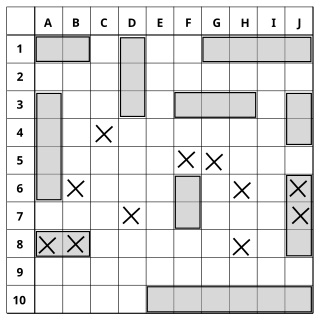 W
WBattleship is a strategy type guessing game for two players. It is played on ruled grids on which each player's fleet of ships are marked. The locations of the fleets are concealed from the other player. Players alternate turns calling "shots" at the other player's ships, and the objective of the game is to destroy the opposing player's fleet.
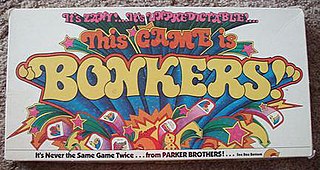 W
WBonkers! is a race-style board game designed by Paul J. Gruen and produced first by Parker Brothers, later by Milton Bradley, and briefly reissued by Winning Moves. The object is to be the first player to score 12 points by adding instruction cards to the empty spaces in an attempt to move to several scoring stations. The game's slogan is "It's Never the Same Game Twice!"
 W
WBradley's Toy Money Complete with Game Of Banking was produced by the Milton Bradley Company.
 W
WBroadsides and Boarding Parties is a board game published by Milton Bradley in 1984 as part of their Gamemaster series. It was the 3rd in the series of games that are all designed by Larry Harris. It is the only game of that series to feature a two player game, Broadsides and Boarding Parties is a duel between a Spanish galleon and a pirate ship. Players take turns moving their ship and firing at the other ship to sink her. If the ships collide then players may take boarding parties onto the other ship to try to win.
 W
WCamp Granada is a 1965 children's board game by Milton Bradley Company based on Allan Sherman's 1963 novelty song "Hello Muddah, Hello Fadduh ". Campers take turns driving a breakdown-prone bus to gather ICKY animals from various summer camp locations to be the first to leave the real rotten camp for home. The game board depicts spikes on the diving board, an octopus in the swimming hole, and a lover's leap into a volcano.
 W
WCandy Land is a simple racing board game published by Hasbro. The game requires no reading and minimal counting skills, making it suitable for young children. No strategy is involved and players are never required to make choices, just follow directions. About one million copies per year are sold.
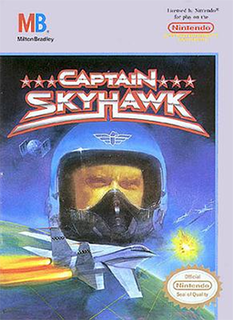 W
WCaptain Skyhawk is a scrolling shooter video game developed by Rare and published by Milton Bradley Company. The game was released in North America in June 1990 and in Europe the next year for the NES. It was also released for the PlayChoice-10 arcade machine.
 W
WConnect Four is a two-player connection board game, in which the players choose a color and then take turns dropping colored discs into a seven-column, six-row vertically suspended grid. The pieces fall straight down, occupying the lowest available space within the column. The objective of the game is to be the first to form a horizontal, vertical, or diagonal line of four of one's own discs. Connect Four is a solved game. The first player can always win by playing the right moves.
 W
WConquest of the Empire is a military strategy board game set in the Roman Empire after the death of Marcus Aurelius, with 2 to 6 players pitting their armies against each other in an attempt to become the ruler of Rome. The game was originally created in 1982 by Larry Harris and published by The Citadel under the title VI Caesars. Harris revised the game for Milton Bradley in 1984 to be reissued under the title Conquest of the Empire as part of the Gamemaster series. The game was re-released in the summer of 2005 by Eagle Games, redesigned by Glenn Drover. The gameplay in Conquest of the Empire shares similarities to Axis & Allies, another Larry Harris project within the same series.
 W
WCrocodile Dentist is a game made for young children, first published by Milton Bradley in 1990. A smaller travel version of the game was released in 1993 and is currently being produced by Winning Moves. The game was conceived by Robert B. Fuhrer, who later created Gator Golf, and many other toys and games.
 W
WDark Tower is a 1981 electronic board game, by Milton Bradley Company, for one to four players. The object of the game is to amass an army, collect the three keys to the Tower, and defeat the evil within. The game came out during the height of the role-playing game craze in the early 1980s. Advertising for the game included a television commercial featuring Orson Welles.
 W
WDon't Break the Ice is a children's tabletop game for two to four players ages 3 and up. Marketed by Schaper Toys in 1968, the game is now manufactured by Hasbro subsidiary Milton Bradley.
 W
WDownfall is a two-player game for players aged 7 and older, first marketed by the Milton Bradley Company in 1970.
 W
WForbidden Bridge is a board game which simulates being a treasure hunter. Players assume the role of explorers who are after ancient jewels, which are guarded by an angry spirit. Occasionally, the bridge guard will awaken and shake the bridge, which can cause players' pieces to fall off. Players also can get the chance to "steal" another player's jewel. The first player to retrieve two jewels and return them all in their boat wins.
 W
WThe Game of Cootie is a children's dice rolling and set collection tabletop game for two to four players. The object is to be the first to build a three-dimensional bug-like object called a "cootie" from a variety of plastic body parts. Created by William Schaper in 1948, the game was launched in 1949 and sold millions in its first years. In 1973, Cootie was acquired by Tyco Toys, and, in 1986, by Hasbro subsidiary Milton Bradley. The game was given a new look and continued to enjoy commercial success. Several companies published cootie games in the first half of the twentieth century, but only Schaper's featured a free-standing, three-dimensional cootie. In 2003, Cootie was named to the Toy Industry Association's "Century of Toys List".
 W
WThe Game of Life, also known simply as Life, is a board game originally created in 1860 by Milton Bradley, as The Checkered Game of Life. The Game of Life was America's first popular parlour game. The game simulates a person's travels through his or her life, from college to retirement, with jobs, marriage, and possible children along the way. Two to four or six players can participate in one game. Variations of the game accommodate up to ten players.
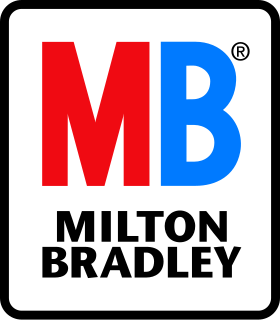 W
WThe Gamemaster Series of board games consists of five war simulation games released by the game company Milton Bradley beginning in 1984. The games were not developed "in-house" by Milton Bradley, with each game initially published in limited runs by smaller game publishers in the early 1980s before their rights were acquired by Milton Bradley. Despite this, some modern reissues of these games refer to the Milton Bradley versions as the "first edition" of each game.
 W
WHeadache is a board game for in which the object is to land a playing piece on top of all opponents' pieces. Play moves in circles until one player has captured every other players' cones on the board and declared the winner. All players are welcome to occupy any space throughout the game, provided the die rolls allow, and there are eight spaces that serve as "safe" spots, where a cone resting on this space cannot be captured. Captured pieces are not sent back to start, but are permanently lost.
 W
WHeroQuest, sometimes written as Hero Quest, is an adventure board game created by Milton Bradley in conjunction with the British company Games Workshop. The game was loosely based around archetypes of fantasy role-playing games: the game itself was actually a game system, allowing the gamemaster to create dungeons of their own design using the provided game board, tiles, furnishings and figures. The game manual describes Morcar/Zargon as a former apprentice of Mentor, and the parchment text is read aloud from Mentor's perspective. Several expansions were released, each adding new tiles, traps, artifacts, and monsters to the core system.
 W
WHeroscape is an expandable turn-based miniature wargaming system originally manufactured by Milton Bradley Company from 2004 to 2008, and later by Wizards of the Coast from 2008 until it was discontinued in November 2010. The game is played using pre-painted miniature figures on a board made from interlocking hexagonal tiles, allowing for the construction of an interchangeable and variable 3D landscape. This system and the relatively high production quality of the game materials are lauded by fans even years after the game was discontinued.
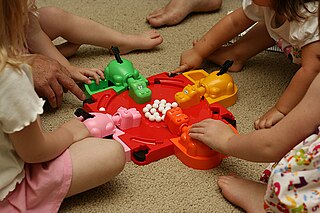 W
WHungry Hungry Hippos is a tabletop game made for 2–4 players, produced by Hasbro, under the brand of its subsidiary, Milton Bradley. The idea for the game was published in 1967 by toy inventor Fred Kroll and it was introduced in 1978. The objective of the game is for each player to collect as many marbles as possible with their "hippo". The game is marketed under the "Elefun and Friends" banner, along with Elefun, Mouse Trap and Gator Golf. The game has been referenced in The Simpsons (1992), Mystery Science Theater 3000, Donnie Darko (2001), Toy Story 3 (2010), My Little Pony: The Movie (2017) and Space Force (2020). There is also a battle level based on the game in the 2016 Micro Machines game.
 W
WJenga is a game of physical skill created by British board game designer and author Leslie Scott and currently marketed by Hasbro. Players take turns removing one block at a time from a tower constructed of 54 blocks. Each block removed is then placed on top of the tower, creating a progressively more unstable structure.
 W
WThe Jolly Darkie Target Game was a game developed and manufactured by the McLoughlin Brothers which was released in 1890. It was produced until at least 1915. Other companies produced similar games, such as Alabama Coon by J. W. Spear & Sons.
 W
WKerPlunk is a children's game invented by Eddy Goldfarb with Rene Soriano and first marketed by the Ideal Toy Company in 1967. The game consists of a transparent plastic tube, plastic rods called straws and several dozen marbles. The base contains four separate numbered trays and the straws are passed through holes in the middle of the tube to form a lattice. The marbles are then placed in the top of the tube and held in place by the lattice. The onomatopoeic name of the game derives from the sound of the marbles tumbling to the base of the tube during play.
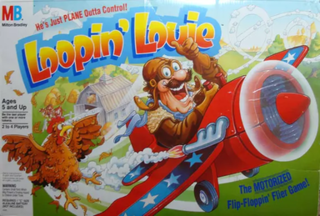 W
WLoopin' Louie, is an interactive electronic board game designed by Carol Wiseley and published by Milton Bradley in 1992. It was given the Kinderspiel des Jahres award in 1994. Although the game is designed for a maximum of 4 players, unofficial modifications were made by modders to increase the maximum number of players to eight. A Star Wars variation called "Loopin' Chewie" was produced by Hasbro in 2015.
 W
WMerlin is a handheld electronic game first made by Parker Brothers in 1978.
 W
WThe Microvision is the first handheld game console that used interchangeable cartridges and in that sense is reprogrammable. It was released by the Milton Bradley Company in November 1979 for a retail price of $49.99.
 W
WMilton is an electronic talking game. According to the patent, Milton was the first electronic talking game that allowed two people to play against each other. Previously released devices of this type, such as Speak & Spell by Texas Instruments, were known primarily as teaching devices rather than competitive games.
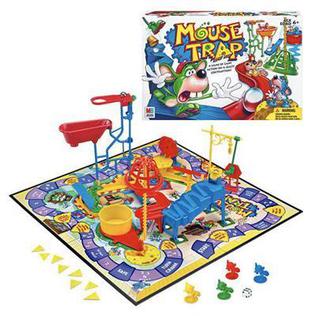 W
WMouse Trap is a board game first published by Ideal in 1963 for two to four players. It is one of the first mass-produced three-dimensional board games. Over the course of the game, players at first cooperate to build a working Rube Goldberg-like mouse trap. Once the mouse trap has been built, players turn against each other, attempting to trap opponents' mouse-shaped game pieces.
 W
WMr. Bucket is a tabletop game and toy published by Milton Bradley and released in 1990, which was discontinued but re-released in 2007. It was discontinued again and re-released again in 2017. The game features a plastic, motorized bucket which ejects differently-colored balls from its mouth. The players use plastic shovels to scoop up the balls and place them back inside Mr. Bucket.
 W
WMystery Date is a board game from the Milton Bradley Company released in 1965, conceived by Marvin Glass and created by Henry Stan. Marketed to girls 6 to 14 years of age, it has been reissued in 1970, 1999, and 2005. It is popularly referenced as an icon and a trope in TV and film.
 W
WOperation is a battery-operated game of physical skill that tests players' eye-hand coordination and fine motor skills. The game's prototype was invented in 1964 by John Spinello, a University of Illinois industrial design student at the time, who sold his rights to the game to renowned toy designer Marvin Glass for a sum of US$500 and the promise of a job upon graduation. Initially produced by Milton Bradley in 1965, Operation is currently made by Hasbro, with an estimated franchise worth of US$40 million.
 W
WPass the Pigs is a commercial version of the dice game Pig, but using custom asymmetrical throwing dice, similar to shagai. It was created by David Moffatt and published by Recycled Paper Products as Pig Mania! in 1977. The publishing license was later sold to Milton Bradley and the game renamed Pass the Pigs. In 1992, publishing rights for North America were sold to Winning Moves Games USA, which acquired the game outright from David Moffat Enterprises in early 2017.
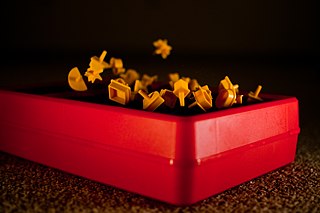 W
WPerfection, originally produced by the Pennsylvania company Reed Toys, is a game by the Milton Bradley company. The object is to put all the pieces into matching holes on the board before the time limit runs out. When time runs out, the board springs up, causing many, if not all, of the pieces to fly out. In the most common version, there are 25 pieces to be placed into a 5×5 grid within 100 seconds.
 W
WPirate and Traveler is a board game published by Milton Bradley in 1911. Revised editions were published in 1936, 1953, 1956, 1960, and 1970. Details of the game board, travel cards, spinner, pawns and box art varied between edition years. The game is no longer in production and is now considered a vintage collectible board game.
 W
WAlex DeMeo's Race America is a racing video game for the Nintendo Entertainment System. The European version received the Chevrolet license to use its Corvette ZR-1 vehicles while those in the North American version had to be redesigned into vehicles that strongly resembled Dodge Vipers.
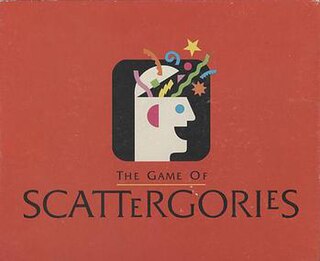 W
WScattergories is a creative-thinking category-based party game originally published by Parker Brothers in 1988. Parker Brothers was purchased by Hasbro a few years later, which published the game internationally under its Milton Bradley brand. The objective of the 2-to-6-player game is to score points by uniquely naming objects within a set of categories, given an initial letter, within a time limit. The game is based on a traditional game called "Categories".
 W
WScotland Yard is a board game in which a team of players controlling different detectives cooperate to track down a player controlling a criminal as they move around a board representing the streets of London. It was first published in 1983. It is named after Scotland Yard - the headquarters of London's Metropolitan Police Service in real-life. Scotland Yard is an asymmetric board game, during which the detective players cooperatively solve a variant of the pursuit–evasion problem. The game is published by Ravensburger in most of Europe and Canada and by Milton Bradley in the United States. It received the Spiel des Jahres award in 1983 - the same year that it was published.
 W
WShenanigans was a children's television game show produced by Heatter-Quigley Productions which aired on ABC Saturday mornings from September 26, 1964 to March 20, 1965, and again from September 25 to December 18, 1965. The series began as local programming in New York City and later aired nationally on ABC. The show was similar to Video Village Junior, another program produced by Heatter-Quigley which featured children as contestants moving about a life-sized game board.
 W
WSimon is an electronic game of memory skill invented by Ralph H. Baer and Howard J. Morrison, working for toy design firm Marvin Glass and Associates, with software programming by Lenny Cope. The device creates a series of tones and lights and requires a user to repeat the sequence. If the user succeeds, the series becomes progressively longer and more complex. Once the user fails or the time limit runs out, the game is over. The original version was manufactured and distributed by Milton Bradley and later by Hasbro after it took over Milton Bradley. Much of the assembly language code was written by Charles Kapps, who taught computer science at Temple University and also wrote one of the first books on the theory of computer programming. Simon was launched in 1978 at Studio 54 in New York City and was an immediate success, becoming a pop culture symbol of the 1970s and 1980s.
 W
WSnakes and ladders, known originally as Moksha Patam, is an ancient Indian board game for two or more players regarded today as a worldwide classic. It is played on a game board with numbered, gridded squares. A number of "ladders" and "snakes" are pictured on the board, each connecting two specific board squares. The object of the game is to navigate one's game piece, according to die rolls, from the start to the finish, helped by climbing ladders but hindered by falling down snakes.
 W
WSpace Crusade is an adventure board game produced by Milton Bradley together with Games Workshop and was first made in 1990. It was produced in the UK and available in some other countries including Finland, Ireland, France, Spain, Denmark, Australia and New Zealand. In Germany, Italy, Belgium and the Netherlands, it is known as Star Quest.
 W
WSquare Mile was the land development board game released by Milton Bradley in 1962. It is for 2 - 4 players ages 12 to adult.
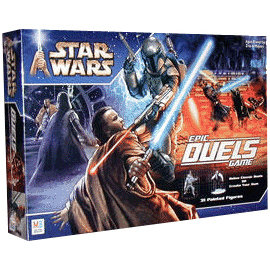 W
WThe Star Wars Epic Duels board game was released by Hasbro in 2002. It was designed for ages 8 and up, and for 2-6 players. The main designer of the game was Craig Van Ness, with assistance from Rob Daviau. It is out of print.
 W
WStay Alive is a strategy game, where 2-4 players try to keep their marbles from falling through holes in the game board while trying to make their opponents' marbles fall through. It was originally published by Milton Bradley in 1971 and marketed in television and print advertising as "the ultimate survival game". Stay Alive was republished with a smaller board by Winning Moves Games USA in 2005. This game is no longer in production.
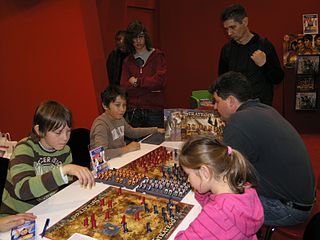 W
WStratego is a strategy board game for two players on a board of 10×10 squares. Each player controls 40 pieces representing individual officer and soldier ranks in an army. The pieces have Napoleonic insignia. The objective of the game is to find and capture the opponent's Flag, or to capture so many enemy pieces that the opponent cannot make any further moves. Stratego has simple enough rules for young children to play but a depth of strategy that is also appealing to adults. The game is a slightly modified copy of an early 20th century French game named L'Attaque. It has been in production in Europe since World War II and the United States since 1961. There are now two- and four-handed versions, versions with 10, 30 or 40 pieces per player, and boards with smaller sizes. There are also variant pieces and different rulesets.
 W
WTaboo is a word, guessing, and party game published by Parker Brothers in 1989. The objective of the game is for a player to have their partners guess the word on the player's card without using the word itself or five additional words listed on the card.
 W
WTales of the Crystals is an interactive children's fantasy role playing game, aimed mostly towards young girls. It was published in 1993 by Milton Bradley Company.
 W
WTime Lord is a side-scrolling action-platform video game developed by Rare and published by Milton Bradley Company for the Nintendo Entertainment System. It was released in North America in September 1990 and in Europe in 1991.
 W
WTorpedo Run! is a 1986 board game published by Milton Bradley in which the object is to destroy your opponents ships before they can destroy yours. The game was part of Milton Bradley's Floor Wars Series. The game was well known for its large board size and large playing pieces.
 W
WTrouble is a board game in which players compete to be the first to send four pieces all the way around a board. Pieces are moved according to the roll of a die. Trouble was developed by Evan Hill and initially manufactured by Dalz., later by Milton Bradley. The game was launched in America in 1965. The classic version is now marketed by Winning Moves Games USA.
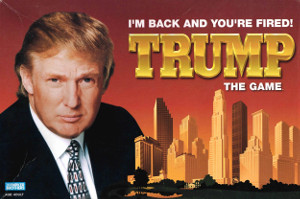 W
WTrump: The Game is a board game named after American businessman Donald Trump. Milton Bradley Company initially released the game in 1989, but it sold poorly, with only 800,000 copies sold out of an expected two million. Parker Brothers re-released Trump: The Game in 2004 following the success of Trump's reality television series, The Apprentice, from earlier that year.
 W
WTwister is a game of physical skill produced by Milton Bradley Company and Winning Moves Games USA. It is played on a large plastic mat that is spread on the floor or ground. The mat has six rows of large colored circles on it with a different color in each row: red, yellow, green, and blue. A spinner is attached to a square board and is used to determine where the player has to put their hand or foot. The spinner is divided into four labeled sections: left foot, right foot, left hand, and right hand. Each of those four sections are divided into the four colors. After spinning, the combination is called and players must move their matching hand or foot to a circle of the correct color. The game promotes itself as "the game that ties you up in knots".
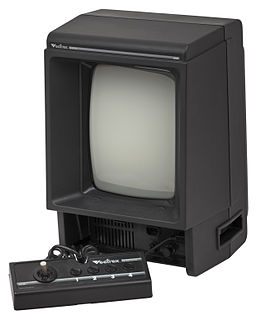 W
WThe Vectrex is a vector display-based home video game console–the only one ever designed and released for the home market, developed by Smith Engineering. It was first released for the North America market in November 1982 and then Europe and Japan in 1983. Originally manufactured by General Consumer Electronics, it was later licensed to Milton Bradley after they acquired the company. Bandai released the system in Japan.
 W
WYahtzee is a dice game made by Milton Bradley, which was first marketed as Yatzie by the National Association Service of Toledo, Ohio, in the early 1940s. It was marketed under the name of Yahtzee by game entrepreneur Edwin S. Lowe in 1956. The game is a development of earlier dice games such as Poker Dice, Yacht and Generala. It is also similar to Yatzy, which is popular in Scandinavia.